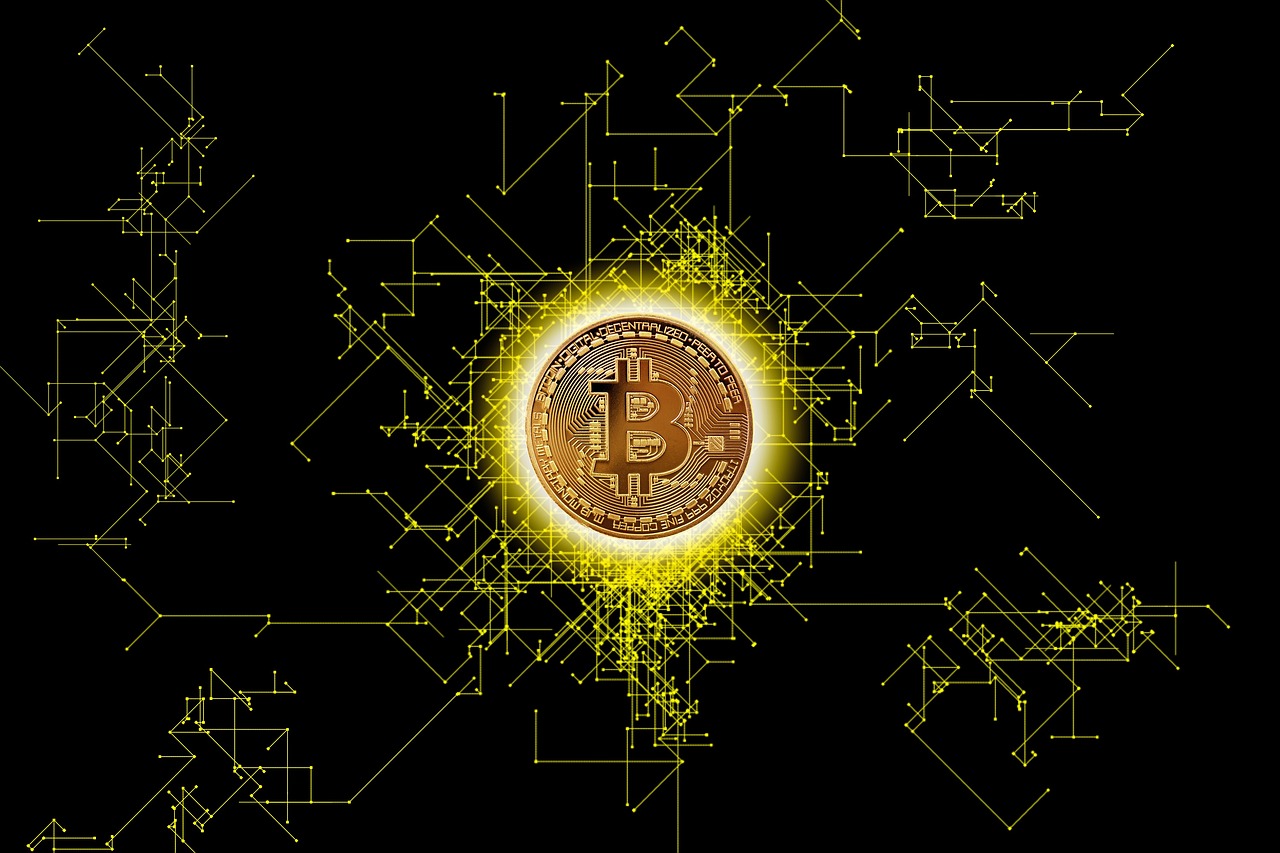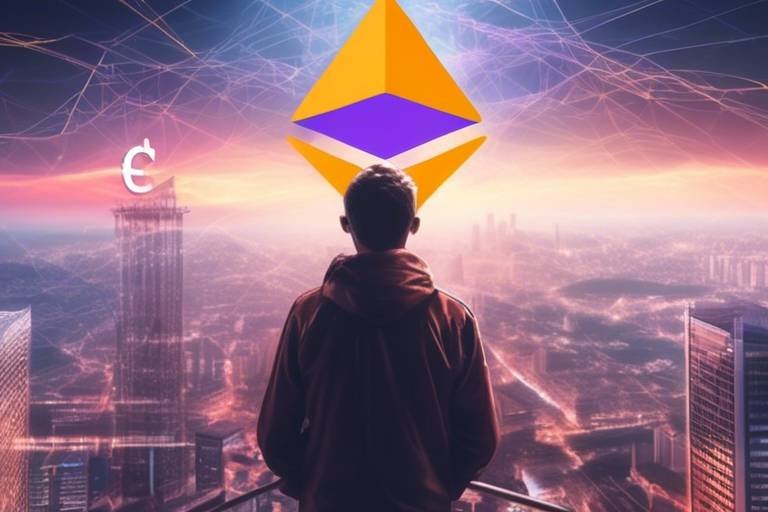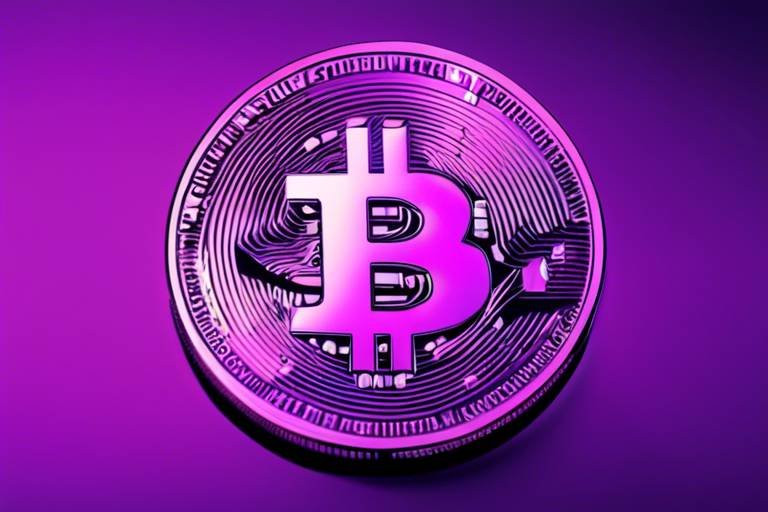Matic Network - Scaling Ethereum to New Heights
The Matic Network is revolutionizing the way we perceive scalability in the blockchain world, particularly for Ethereum. Imagine trying to navigate a bustling city during rush hour; that's what using Ethereum can feel like with its current congestion issues. Matic Network is like the express lane that allows users to bypass the traffic, offering a smoother and faster experience. This layer-2 scaling solution is engineered to enhance transaction speeds, slash fees, and make decentralized applications (dApps) more accessible. By addressing these critical challenges, Matic Network is not just improving the user experience but also paving the way for a broader adoption of blockchain technology.
At its core, Matic Network is a layer-2 scaling solution specifically designed for Ethereum. It leverages innovative technology to improve transaction speeds and dramatically reduce costs. Think of Matic as an efficient highway built alongside a congested road; it allows for faster travel while alleviating the burden on the main thoroughfare. This means that developers can build dApps that are not only more efficient but also more user-friendly. With Matic, the vision of a seamless and scalable Ethereum ecosystem is becoming a reality.
Matic Network is packed with standout features that make it a formidable player in the blockchain arena. These features include:
- Proof-of-Stake Consensus Mechanism: Enhances security and decentralization.
- Sidechain Technology: Offloads transactions from the Ethereum mainchain.
- Seamless Interoperability: Facilitates easy interaction with Ethereum.
These components work together to create a robust infrastructure that not only boosts performance but also enhances the overall user experience.
The Proof-of-Stake (PoS) mechanism implemented by Matic Network is a game-changer. It enhances security and decentralization, allowing validators to earn rewards while ensuring the network's integrity remains intact. This system is akin to a community watch program, where everyone plays a role in keeping the neighborhood safe. Validators confirm transactions and secure the blockchain, making it robust and trustworthy for users. This collaborative effort ensures that the network operates efficiently and remains resilient against potential threats.
Validator nodes are the backbone of the Matic Network. They play a crucial role by confirming transactions and securing the blockchain. Without these dedicated nodes, the network would struggle to maintain its integrity and performance. Picture them as the lifeguards at a busy beach, ensuring that everyone is safe while enjoying the waves.
Another enticing aspect of Matic Network is the opportunity for participants to earn staking rewards. By locking their tokens in the network, users can enjoy passive income while contributing to the ecosystem's stability and growth. It's like planting a tree that bears fruit; the more you nurture it, the more rewards you reap. This incentivizes users to engage with the network actively, fostering a thriving community.
Matic Network's use of sidechain technology is a key factor in its ability to offload transactions from the Ethereum mainchain. This significantly reduces congestion and enhances transaction speeds for both dApps and users. Imagine a busy restaurant that opens an additional dining area to accommodate more guests; that's what Matic does for Ethereum, allowing more transactions to occur simultaneously without the usual bottlenecks.
One of the standout features of Matic Network is its seamless interoperability with Ethereum. This design allows developers to easily migrate their dApps, enabling users to benefit from improved performance without the hassle of switching platforms. It's like having a universal remote that works with all your devices; it simplifies your life and enhances your experience.
The Matic Bridge is another innovative feature that facilitates the transfer of assets between Ethereum and Matic. This bridge allows users to move tokens effortlessly while taking advantage of lower fees and faster transactions. Think of it as a toll-free bridge that connects two bustling cities, offering travelers a quick and cost-effective route.
Matic Network supports a vibrant developer ecosystem, providing tools and resources that empower developers to create innovative dApps. This nurturing environment is akin to a creative workshop where ideas can flourish and grow. By fostering collaboration and innovation, Matic is helping to shape the future of blockchain technology.
The versatility of Matic Network is evident in its diverse range of use cases. From gaming and decentralized finance (DeFi) to NFT marketplaces, Matic showcases its potential to transform various industries within the blockchain realm. Picture a toolbox filled with various tools; Matic is that toolbox, equipped to tackle different challenges across multiple sectors.
Q1: What is Matic Network?
A1: Matic Network is a layer-2 scaling solution for Ethereum designed to enhance transaction speeds and reduce fees for decentralized applications.
Q2: How does the Proof-of-Stake mechanism work?
A2: The Proof-of-Stake mechanism allows validators to earn rewards for confirming transactions and securing the network, enhancing decentralization and security.
Q3: What are the benefits of using Matic Network?
A3: Users benefit from faster transactions, lower fees, and enhanced accessibility to decentralized applications.
Q4: Can developers easily migrate their dApps to Matic?
A4: Yes, Matic's design allows for seamless interaction with Ethereum, making it easy for developers to migrate their dApps.

Understanding Matic Network
This article explores the Matic Network's innovative solutions for enhancing Ethereum's scalability, security, and user experience, as well as its impact on the broader blockchain ecosystem.
Matic Network, now known as Polygon, is a layer-2 scaling solution for Ethereum that aims to tackle one of the most pressing issues facing the blockchain today: scalability. Imagine trying to squeeze into a crowded subway car during rush hour; that's what using Ethereum can feel like during peak times. Matic Network alleviates this congestion, allowing users to enjoy faster transaction speeds and significantly lower fees. By enhancing the overall efficiency of decentralized applications (dApps), Matic makes blockchain technology more accessible to everyone.
At its core, Matic Network employs a combination of advanced technologies to create a seamless experience for users and developers alike. This includes utilizing a Proof-of-Stake (PoS) consensus mechanism, which not only enhances security but also decentralizes the network. Think of it as a community garden where everyone pitches in to maintain the beauty of the space; the more people involved, the more vibrant and secure it becomes. With Matic, validators play a crucial role in confirming transactions, ensuring that the network remains trustworthy and efficient.
Another key aspect of Matic Network is its use of sidechain technology. This innovative approach allows transactions to be processed on a separate chain, reducing the load on the Ethereum mainchain. Picture a busy highway with multiple lanes; sidechains act like those additional lanes, allowing traffic to flow smoothly without bottlenecks. This means that dApps can function more efficiently, providing a better user experience without the high costs typically associated with Ethereum transactions.
Moreover, Matic Network is designed for interoperability with Ethereum, making it easy for developers to migrate their dApps with minimal friction. This is crucial in a rapidly evolving ecosystem where flexibility and adaptability are key. The Matic Bridge, for instance, enables users to transfer assets between Ethereum and Matic effortlessly, taking advantage of lower fees and faster transaction times. It’s like having a fast-pass at an amusement park; you get to skip the long lines and enjoy the rides!
In summary, Matic Network is not just a solution; it’s a revolution in the blockchain space. By enhancing scalability, security, and user experience, it paves the way for a more efficient and accessible decentralized future. Whether you’re a developer looking to create the next big dApp or a user wanting to explore the world of blockchain without the hassle of high fees and slow transactions, Matic Network has something to offer.
- What is Matic Network? Matic Network, now known as Polygon, is a layer-2 scaling solution for Ethereum that enhances transaction speeds and reduces fees.
- How does Matic Network improve scalability? By utilizing sidechain technology and a Proof-of-Stake consensus mechanism, Matic Network processes transactions off the Ethereum mainchain, reducing congestion.
- Can developers easily migrate their dApps to Matic Network? Yes, Matic Network is designed for seamless interoperability with Ethereum, allowing developers to move their dApps with ease.
- What benefits do users gain from using Matic Network? Users enjoy faster transactions, lower fees, and a more efficient experience when interacting with dApps.

Key Features of Matic Network
The Matic Network is not just another blockchain; it's a revolutionary layer-2 scaling solution that brings a plethora of features designed to enhance the Ethereum experience. Imagine a bustling highway during rush hour; that's Ethereum at times, with transactions piling up and fees skyrocketing. Matic swoops in like a well-planned bypass, allowing traffic to flow smoothly. Key features such as its Proof-of-Stake consensus mechanism, sidechain technology, and seamless interoperability with Ethereum are what truly set it apart.
First up is the Proof-of-Stake (PoS) mechanism. This isn't just about speed; it’s about security and decentralization too. Validators, the backbone of the Matic Network, are rewarded for their efforts in maintaining the network's integrity. Think of them as the diligent referees of a soccer match, ensuring that every play is fair and square while also earning rewards for their vigilance. This mechanism not only secures the network but also encourages more people to participate, creating a vibrant ecosystem where everyone can benefit.
Validator nodes are the unsung heroes of the Matic Network. They confirm transactions and secure the blockchain, ensuring that every transaction is legitimate and trustworthy. Without these nodes, the network would be akin to a ship without a captain, lost at sea. These nodes are distributed across the globe, adding an extra layer of decentralization that is crucial for any blockchain. The more nodes that participate, the more robust and resilient the network becomes.
One of the most enticing aspects of Matic Network is the opportunity for participants to earn staking rewards. By locking their tokens in the network, users can contribute to its stability while enjoying a passive income. It’s like planting a tree; with time and care, it grows and provides shade. Similarly, staking not only helps the network but also allows users to reap benefits as their investment flourishes. This feature encourages long-term commitment, which is vital for the ecosystem's growth.
Now, let’s talk about sidechain technology. Matic Network employs this innovative approach to offload transactions from the Ethereum mainchain, significantly reducing congestion. Picture a busy restaurant with a long line; if they had a second entrance, it would ease the flow of customers. That's exactly what Matic does for Ethereum. By utilizing sidechains, Matic enables dApps to operate at lightning speed, providing an enhanced user experience while keeping costs down. This means that developers can build applications that are not only efficient but also cost-effective.
Another standout feature is Matic's seamless interoperability with the Ethereum blockchain. This design allows developers to migrate their dApps effortlessly, taking advantage of the enhanced performance offered by Matic. It’s like having a universal remote that can control multiple devices; developers can switch between Ethereum and Matic without missing a beat. The Matic Bridge facilitates this process, enabling users to transfer assets between the two networks with ease.
In conclusion, the key features of Matic Network not only improve scalability and performance but also create a more user-friendly environment for both developers and users. With its innovative approach to consensus, transaction processing, and interoperability, Matic is paving the way for a more efficient blockchain ecosystem.
- What is Matic Network? Matic Network is a layer-2 scaling solution for Ethereum that enhances transaction speeds and reduces fees.
- How does Proof-of-Stake work in Matic Network? Validators earn rewards for confirming transactions and maintaining the network's integrity.
- What are sidechains? Sidechains are separate blockchains that run parallel to the main Ethereum chain, allowing for faster and cheaper transactions.
- Can developers easily migrate their dApps to Matic? Yes, Matic Network is designed for seamless interoperability with Ethereum, making migration straightforward.

Proof-of-Stake Mechanism
The Proof-of-Stake (PoS) mechanism implemented by the Matic Network is a game changer in the world of blockchain technology. Unlike the traditional Proof-of-Work (PoW) model, which requires extensive computational power and energy consumption, PoS allows validators to confirm transactions based on the number of tokens they hold and are willing to "stake." This not only enhances the network's security but also promotes a more environmentally friendly approach to maintaining blockchain integrity.
In the Matic Network, validators are selected to create new blocks and confirm transactions based on their stake in the network, which means that the more tokens a validator holds, the higher their chances of being chosen to validate transactions. This creates a system where participants are incentivized to act honestly and maintain the network's integrity, as dishonest actions could lead to losing their staked tokens. It's akin to a community where everyone has a vested interest in keeping the peace—nobody wants to rock the boat when their own resources are on the line!
Moreover, the PoS mechanism contributes to decentralization. With many validators participating, the control over the network is distributed rather than concentrated in the hands of a few. This decentralization is crucial for building trust within the ecosystem, as it ensures that no single entity can manipulate the network for personal gain. To illustrate this, consider the following table that outlines the key differences between PoW and PoS:
| Feature | Proof-of-Work (PoW) | Proof-of-Stake (PoS) |
|---|---|---|
| Energy Consumption | High | Low |
| Transaction Speed | Slower | Faster |
| Centralization Risk | Higher | Lower |
| Validator Selection | Randomized based on computational power | Based on the amount staked |
In addition to enhancing security and decentralization, the PoS mechanism allows for staking rewards. Participants can earn rewards by locking their tokens in the network, which not only incentivizes them to contribute to the ecosystem's stability but also provides them with a source of passive income. This creates a win-win situation where users can grow their investment while supporting the network's growth. Think of it as planting a seed: the more you nurture it, the more it flourishes!
In summary, the Proof-of-Stake mechanism is a vital component of the Matic Network, enhancing security, decentralization, and user participation. By allowing validators to earn rewards and maintain the network's integrity, Matic is paving the way for a more efficient and sustainable blockchain ecosystem.

Validator Nodes
Validator nodes are the backbone of the Matic Network, ensuring the integrity and security of the blockchain. Think of them as the diligent gatekeepers, tirelessly confirming transactions and maintaining the overall health of the network. Without these nodes, the entire system could falter, leading to potential security breaches and inefficiencies. Each validator node is responsible for verifying the legitimacy of transactions, and they play a crucial role in preventing double-spending—an issue that can plague many blockchain systems.
What makes validator nodes particularly fascinating is their Proof-of-Stake mechanism. Unlike traditional Proof-of-Work systems that rely on energy-intensive mining, Matic's approach allows validators to stake their tokens as collateral. This not only enhances security but also promotes decentralization. When validators stake their tokens, they have a vested interest in maintaining the network's integrity, as any malicious activity could result in losing their staked assets. It's like putting your money where your mouth is—validators are financially incentivized to keep the network running smoothly.
To give you a clearer picture of how validator nodes function within the Matic ecosystem, here’s a breakdown of their key responsibilities:
- Transaction Validation: Validator nodes check and confirm the authenticity of transactions before they are added to the blockchain.
- Block Creation: They are responsible for creating new blocks, which are then added to the blockchain, ensuring a continuous flow of transactions.
- Network Security: By actively participating in the network, they help to deter malicious attacks and maintain a secure environment for all users.
In addition to these responsibilities, validator nodes also play a vital role in the community. They help educate new participants about the staking process and the importance of maintaining a secure network. This community-driven approach fosters a sense of collaboration and trust among users, further solidifying the Matic Network's reputation as a reliable platform.
To sum it up, validator nodes are not just technical components; they are integral to the success and security of the Matic Network. Their commitment to validating transactions and securing the blockchain ensures that users can interact with decentralized applications (dApps) confidently, knowing that their transactions are being handled by trustworthy custodians. As the network continues to grow, the importance of these nodes will only increase, making them a critical element in the ongoing evolution of blockchain technology.
- What is a validator node? A validator node is a participant in the Matic Network that confirms transactions and maintains the blockchain's integrity.
- How do validator nodes earn rewards? Validator nodes earn rewards by staking their tokens and participating in the network's consensus mechanism.
- Can anyone become a validator? Yes, anyone can become a validator by staking the required amount of MATIC tokens and running a validator node.

Staking Rewards
Staking rewards are one of the most appealing aspects of the Matic Network, inviting users to participate in its ecosystem while earning a passive income. Think of it as planting a seed in a garden; with time, care, and a bit of patience, that seed can grow into a flourishing plant, yielding fruits for you to enjoy. In the case of Matic, when you stake your tokens, you're essentially locking them up to help secure the network, and in return, you receive rewards that can significantly enhance your overall returns.
But how does it work? When you stake your MATIC tokens, you're contributing to the network's security and efficiency. This process involves validators who confirm transactions and maintain the integrity of the blockchain. In exchange for your contribution, you earn staking rewards, which are distributed in the form of additional MATIC tokens. The more tokens you stake, the higher your potential rewards, creating a win-win situation for both the network and its participants.
To give you a clearer picture, here’s a breakdown of the staking rewards mechanism:
| Aspect | Description |
|---|---|
| Staking Period | The duration for which you lock your tokens, typically ranging from a few days to several months. |
| Annual Percentage Yield (APY) | The interest rate you can earn on your staked tokens, often varying based on network conditions and the total amount staked. |
| Validator Selection | You can choose which validator to delegate your tokens to, influencing your rewards based on their performance. |
Moreover, staking not only rewards you financially but also fosters a sense of community within the Matic ecosystem. By participating in staking, you're making a commitment to the network's success, helping it grow stronger and more resilient against potential threats. It’s like being part of a team where everyone plays a crucial role in achieving a common goal.
In conclusion, staking rewards on the Matic Network are an excellent way to earn passive income while contributing to the overall health and security of the blockchain. Whether you're a seasoned investor or just starting, getting involved in staking can be a rewarding experience, both financially and personally. So, why not dive in and start reaping the benefits today?
- What is staking in the Matic Network? Staking involves locking your MATIC tokens to help secure the network, in return for which you earn rewards.
- How are staking rewards calculated? Rewards are typically based on the amount of tokens you stake and the performance of the validator you choose.
- Can I unstake my tokens anytime? While you can usually unstake your tokens, there may be a waiting period before you can access them again.
- What are the risks associated with staking? Risks include potential loss of rewards if the validator performs poorly, as well as market volatility affecting the value of your staked tokens.

Sidechain Technology
The Matic Network leverages to revolutionize how transactions are processed on the Ethereum blockchain. Imagine a busy highway where traffic is constantly jammed; now picture a series of alternate routes that allow cars to bypass congestion and reach their destination faster. That’s precisely what sidechains do for Ethereum. By offloading transactions from the main Ethereum chain, Matic significantly enhances transaction speeds and reduces fees, creating a smoother experience for decentralized applications (dApps) and their users.
When transactions are processed on the Matic sidechain, they are confirmed quickly and efficiently, allowing dApps to operate without the delays typically associated with high traffic on the Ethereum mainchain. This not only improves user satisfaction but also encourages more developers to build on the Matic platform, knowing their applications can handle a larger user base without performance hiccups.
One of the standout benefits of Matic's sidechain technology is its low latency. Transactions on the Matic sidechain can be confirmed in just a few seconds, compared to the longer wait times on the Ethereum mainchain. This speed is crucial for applications where real-time interactions are essential, such as gaming or financial transactions. Furthermore, the reduction in gas fees makes it economically viable for users to engage with dApps without worrying about exorbitant costs eating into their profits.
Let’s break down some key advantages of Matic’s sidechain technology:
- Scalability: The sidechain can handle thousands of transactions per second, vastly improving the throughput compared to the Ethereum mainchain.
- Cost-Effectiveness: Lower transaction fees make it more accessible for everyday users and developers alike.
- Enhanced User Experience: Faster transaction confirmations lead to a more satisfying interaction with dApps.
Moreover, Matic’s sidechain is designed to be secure and decentralized. It utilizes a network of validators to ensure that all transactions are legitimate and that the integrity of the blockchain is maintained. This decentralized approach not only protects users but also fosters trust in the ecosystem, making it a favorable choice for developers looking to build reliable applications.
In summary, sidechain technology is a game-changer for the Matic Network. By enabling faster transactions, reducing costs, and maintaining a secure environment, it paves the way for a more efficient and user-friendly blockchain experience. As more dApps migrate to Matic, we can expect to see an explosion of innovation and creativity in the decentralized space, transforming how we interact with blockchain technology.
Q1: What is a sidechain?
A sidechain is a separate blockchain that is attached to a parent blockchain (like Ethereum) and allows for transactions to be processed independently, improving scalability and efficiency.
Q2: How does Matic Network's sidechain technology work?
Matic’s sidechain processes transactions off the Ethereum mainchain, allowing for faster confirmations and lower fees, while still maintaining a connection to Ethereum for asset transfers.
Q3: What are the benefits of using Matic Network for dApps?
Developers can benefit from Matic's high transaction speeds, low fees, and a secure environment, enabling them to create more efficient and user-friendly applications.
Q4: Can I move my assets between Ethereum and Matic?
Yes, the Matic Bridge facilitates easy transfer of assets between the Ethereum blockchain and the Matic sidechain.

Interoperability with Ethereum
The Matic Network is not just a standalone entity; it is intricately woven into the fabric of the Ethereum blockchain, creating a harmonious relationship that enhances the overall user experience. This interoperability is crucial for developers and users alike, as it allows for seamless interaction between the two networks. Imagine being able to hop from one platform to another without any friction—this is what Matic Network offers!
One of the standout features of Matic's interoperability is the Matic Bridge. This innovative tool facilitates the transfer of assets between Ethereum and Matic, making it incredibly easy for users to move their tokens back and forth. Why is this important? Well, it means that users can take advantage of Matic's lower fees and faster transaction speeds while still accessing the vast ecosystem of Ethereum. It’s like having the best of both worlds at your fingertips!
Furthermore, the Matic Network is designed to support developers in migrating their decentralized applications (dApps) from Ethereum without a hitch. This is a game changer for those who want to leverage Matic’s enhanced performance while maintaining their existing user base. Developers can focus on building amazing features rather than getting bogged down with complex migration processes. The ease of transitioning dApps to the Matic Network opens up a treasure trove of possibilities for innovation.
To illustrate the benefits of this interoperability, let’s take a quick look at a comparison table:
| Feature | Ethereum | Matic Network |
|---|---|---|
| Transaction Speed | Slow (15-30 seconds) | Fast (2 seconds) |
| Transaction Fees | High ($2-$10) | Low (less than $0.01) |
| Scalability | Limited | High (up to 65,000 TPS) |
This table highlights just how significant the differences are between Ethereum and the Matic Network. Users can enjoy lightning-fast transactions and minimal fees, all while interacting with the Ethereum ecosystem. It’s a win-win situation!
Moreover, the Matic Network fosters a vibrant community of developers who are eager to create new dApps that can thrive on its platform. This community-driven approach not only enhances the quality of applications available but also encourages collaboration and innovation. As more developers join the Matic ecosystem, the potential for groundbreaking projects continues to grow, ultimately benefiting all users.
In summary, the interoperability between Matic Network and Ethereum is a critical aspect of its design. By enabling seamless asset transfers and simplifying the migration of dApps, Matic Network empowers users and developers to harness the full potential of blockchain technology. As we move forward, this synergy will likely play a significant role in shaping the future of decentralized applications, making them more accessible and efficient for everyone.

Bridging Assets
The concept of is pivotal in the Matic Network ecosystem, as it facilitates the seamless transfer of digital assets between the Ethereum mainchain and the Matic sidechain. This innovative feature is not just a technical marvel; it serves as a gateway for users to experience faster transactions and lower fees, which are often the bane of Ethereum's congested network. Imagine trying to send a package during the holiday season—everything is slow, and the costs skyrocket. Now, think of the Matic Bridge as a dedicated courier service that ensures your package gets delivered quickly and affordably, no matter the time of year.
When users want to move their tokens from Ethereum to Matic, they can utilize the Matic Bridge, which simplifies the entire process. This bridge employs a two-way peg mechanism, allowing assets to be locked on the Ethereum side while equivalent assets are minted on the Matic side. This ensures that the total supply remains consistent and secure across both networks. The process is not only efficient but also enhances the user experience, making it incredibly straightforward to navigate.
Here’s a brief overview of how the bridging process works:
| Step | Description |
|---|---|
| 1 | User initiates the transfer on the Matic Bridge interface. |
| 2 | Assets are locked on the Ethereum mainchain. |
| 3 | Equivalent assets are minted on the Matic sidechain. |
| 4 | User can now transact with lower fees and faster speeds on Matic. |
| 5 | To transfer back, the process is reversed: assets are burned on Matic and released from Ethereum. |
This bridging capability not only enhances liquidity but also opens up a world of opportunities for decentralized applications (dApps) to thrive on the Matic Network. Developers can create applications that leverage the low-cost and high-speed transactions of Matic while still maintaining the security and decentralization of Ethereum. It's like having the best of both worlds—speed and security, all wrapped up in one neat package.
Moreover, the Matic Bridge is designed to be user-friendly, ensuring that even those who are new to blockchain technology can easily navigate the process. With clear instructions and a simple interface, users can confidently manage their assets without feeling overwhelmed. In a world where technology can often seem daunting, Matic Network is paving the way for a more accessible and inclusive blockchain experience.
In conclusion, bridging assets through the Matic Network is a game-changer. It not only enhances the overall efficiency of transactions but also empowers users to take full advantage of the blockchain's potential without the usual headaches associated with high fees and slow processing times. As the blockchain space continues to evolve, Matic Network stands out as a beacon of innovation, driving the future of decentralized finance and beyond.
- What is the Matic Bridge? The Matic Bridge is a tool that allows users to transfer assets between the Ethereum mainchain and the Matic sidechain seamlessly.
- How do I use the Matic Bridge? Users can initiate transfers through the Matic Bridge interface, where they can lock their assets on Ethereum and mint equivalent assets on Matic.
- Are there any fees associated with bridging assets? Yes, while the Matic Network significantly reduces transaction fees, there may still be minimal costs involved in the bridging process.
- Can I bridge any Ethereum token to Matic? Most Ethereum tokens can be bridged to Matic, but it's always best to check the current supported tokens on the Matic Bridge platform.

Developer Ecosystem
The Matic Network has cultivated a thriving that stands as a beacon for innovation in the blockchain space. With its user-friendly tools and resources, it empowers developers to create and deploy decentralized applications (dApps) with remarkable ease. Imagine a vibrant marketplace where ideas flourish and creativity knows no bounds—that’s the essence of the Matic developer community. By providing comprehensive documentation, SDKs, and APIs, Matic ensures that developers can focus on building rather than grappling with technical hurdles.
One of the standout features of the Matic developer ecosystem is its commitment to interoperability. Developers can seamlessly integrate their projects with Ethereum, leveraging the strengths of both platforms. This means that if you’re a developer looking to enhance your dApp's performance, you can tap into Matic’s capabilities without starting from scratch. It’s like having a powerful toolkit at your disposal, ready to elevate your project to new heights.
Furthermore, the Matic Network hosts various hackathons and developer contests, fostering a spirit of collaboration and competition. These events not only incentivize developers to push their limits but also allow them to showcase their work to a broader audience. The sense of community is palpable; developers share insights, troubleshoot challenges, and celebrate each other's successes. It’s a dynamic environment where learning and growth are part of the journey.
To illustrate the breadth of tools available, here’s a quick overview of some key resources offered by Matic:
| Resource | Description |
|---|---|
| Documentation | Comprehensive guides and tutorials to help developers navigate the Matic ecosystem. |
| SDKs | Software Development Kits that simplify the integration of Matic into existing projects. |
| APIs | Application Programming Interfaces that facilitate interaction with the Matic blockchain. |
Moreover, Matic’s focus on community engagement is evident through its active forums and social media presence. Developers can connect, collaborate, and seek help from others who share their passion for blockchain technology. This sense of belonging is crucial in an industry that can often feel isolating. By joining the Matic community, developers not only gain access to invaluable resources but also become part of a larger movement aimed at revolutionizing how we interact with technology.
In summary, the Matic Network’s developer ecosystem is a fertile ground for creativity and innovation. With its robust tools, supportive community, and commitment to interoperability, it provides everything developers need to bring their ideas to life. Whether you’re a seasoned developer or just starting your journey, Matic offers the environment and resources to help you succeed in the ever-evolving world of blockchain.
- What is the Matic Network?
The Matic Network is a layer-2 scaling solution for Ethereum designed to enhance transaction speeds and reduce fees. - How does Matic improve transaction speeds?
Matic uses sidechain technology to offload transactions from the Ethereum mainchain, significantly reducing congestion. - Can developers easily migrate their dApps to Matic?
Yes, Matic's design allows for seamless interaction with the Ethereum blockchain, making migration straightforward. - What resources are available for developers on Matic?
Matic offers extensive documentation, SDKs, APIs, and community support to assist developers.

Use Cases of Matic Network
The Matic Network, now known as Polygon, is not just a technological marvel; it’s a versatile platform that is redefining how we interact with blockchain technology. With its impressive scalability and low transaction fees, Matic Network has opened the floodgates for numerous use cases that span across various industries. Imagine a world where your gaming experience is seamless, your decentralized finance (DeFi) transactions are lightning-fast, and your digital collectibles are easily traded. That’s the power of Matic Network!
One of the most prominent use cases is found in the gaming industry. Developers are leveraging Matic's capabilities to create immersive gaming experiences that require quick and efficient transactions. Traditional gaming platforms often struggle with lag and high fees, but games built on Matic can offer real-time interactions and in-game economies that are both engaging and rewarding. For instance, games like Axie Infinity and Decentraland have started integrating Matic to enhance their user experience.
In the realm of DeFi, Matic Network is making waves by enabling faster and cheaper transactions for users looking to lend, borrow, or trade assets. The decentralized exchanges (DEXs) built on Matic, such as SushiSwap and QuickSwap, allow users to swap tokens with minimal fees and maximum speed. This efficiency not only attracts more users but also encourages more innovative financial products to emerge. With Matic, the DeFi landscape is evolving rapidly, making it easier for anyone to participate in this financial revolution.
Another fascinating application of Matic Network is in the realm of Non-Fungible Tokens (NFTs). The NFT marketplaces built on Matic are thriving due to the platform's ability to process transactions quickly and affordably. Artists and creators can mint, buy, and sell their digital art without worrying about exorbitant gas fees. This democratization of art and collectibles is reshaping how we perceive ownership in the digital world. Platforms like OpenSea and Rarible are capitalizing on Matic’s technology to enhance user experience.
Furthermore, Matic Network is making strides in the supply chain and logistics sectors. By utilizing its blockchain technology, businesses can track their goods in real-time, ensuring transparency and reducing fraud. Imagine being able to verify the authenticity of a luxury item or the origin of your food with just a scan! This level of transparency not only builds trust among consumers but also streamlines operations for companies.
In summary, Matic Network is paving the way for a multitude of applications across different domains. From gaming and DeFi to NFTs and supply chain management, its impact is profound and far-reaching. The ability to scale Ethereum while enhancing user experience is what makes Matic a game-changer in the blockchain ecosystem. As we look to the future, we can only imagine the innovative solutions that will continue to emerge from this dynamic platform.
- What is Matic Network? Matic Network, now known as Polygon, is a layer-2 scaling solution for Ethereum that enhances transaction speeds and reduces fees.
- How does Matic Network improve gaming experiences? By providing faster and cheaper transactions, it allows for real-time interactions and engaging in-game economies.
- What role does Matic play in DeFi? Matic enables decentralized exchanges to operate efficiently, allowing users to trade assets with minimal fees.
- Can I create and trade NFTs on Matic Network? Yes, many NFT marketplaces built on Matic offer low fees and quick transactions for minting and trading digital art.
- How does Matic enhance supply chain transparency? Matic's blockchain technology allows businesses to track goods in real-time, ensuring authenticity and reducing fraud.
Frequently Asked Questions
- What is the Matic Network?
The Matic Network is a layer-2 scaling solution for Ethereum that enhances transaction speeds and reduces fees. It aims to make decentralized applications (dApps) more accessible and efficient for users, ultimately improving the overall user experience on the Ethereum blockchain.
- How does Matic Network improve scalability?
Matic Network employs sidechain technology to offload transactions from the Ethereum mainchain. This significantly reduces congestion and allows for faster transaction speeds, making it ideal for dApps that require quick and efficient processing.
- What is the Proof-of-Stake mechanism in Matic Network?
The Proof-of-Stake (PoS) mechanism in Matic Network enhances security and decentralization. It allows validators to confirm transactions and earn rewards, thereby maintaining the network's integrity while providing a more energy-efficient alternative to traditional Proof-of-Work systems.
- How can I earn staking rewards on Matic Network?
Participants can earn staking rewards by locking their tokens in the Matic Network. This incentivizes users to contribute to the ecosystem's stability and growth while enjoying passive income from their staked assets.
- What is the role of validator nodes in Matic Network?
Validator nodes are crucial in the Matic Network as they confirm transactions and secure the blockchain. Their role ensures that the network remains robust and trustworthy for all users, contributing to the overall security of the ecosystem.
- How does Matic Network facilitate asset transfers?
The Matic Bridge allows users to transfer assets between Ethereum and Matic seamlessly. This feature enables users to move tokens effortlessly, taking advantage of lower fees and faster transactions, making it easier to manage digital assets.
- What types of applications can be built on Matic Network?
Matic Network supports a wide range of applications, including gaming, decentralized finance (DeFi), and NFT marketplaces. Its versatility makes it a great platform for developers looking to innovate and transform various industries within the blockchain realm.
- Is Matic Network compatible with existing Ethereum dApps?
Yes! Matic Network is designed for seamless interoperability with Ethereum. Developers can easily migrate their existing dApps to Matic to benefit from improved performance and reduced transaction costs.



















